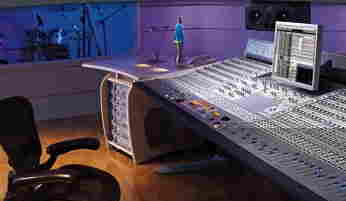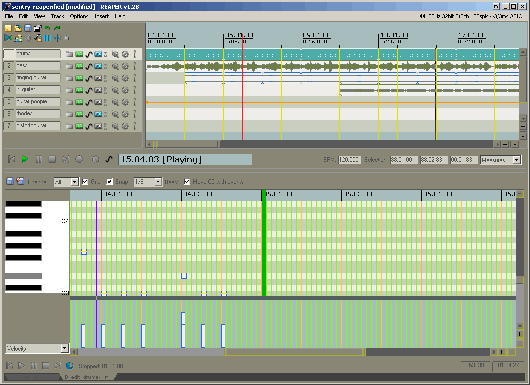|
Recording Systems
Life used to be fairly simple. There was no multitrack and the
only way to record anything was to draw a wavy line, either in the form of a wiggly groove on a disk, or in the form of a
wiggly line on film (the optical soundtrack).
Then the Magnetofon came along and soon was called the tape recorder.
This technology culminated in the magnificent multitrack machines of the eighties which were able to record 24 tracks at one
and the same time on two-inch wide tape. The machines and their tape were expensive and one needed of course a large
and even more expensive mixing desk to get the signal on and off that tape.
The first steps taken by digital technology would hardly have lead
anyone to believe that this would one day be capable of performing almost every task in the studio. Indeed,
the patent engineer in Berlin who granted a patent to the first converter capable of turning an audio signal
into a digital stream, commented "An interesting idea, but of no practical value."
Although the first digital recorders used various forms of tape, this
was just a minor diversion and today all studio recordings are performed on some kind of harddisk. I suppose
one day, the harddisk too will be replaced with a solid state memory of some kind, but with harddisks becoming cheaper, larger
and faster almost by the week, we may still have a few years of harddisk usage left.
Open the DAW
The recorder of today is now called a DAW (Digital Audio Workstation) and
either a dedicated box, or more usually, a PC or Mac with additional hardware and software. Although the nuts and bolts
of these systems are very much the same, they differ in their ease of use and complexity from something like RADAR that seeks
to be as easy and simple to use as a tape recorder, through to Mac-based Logic that is very, very deep, but takes a long time
to learn how to use it properly.
| The ProTools ICON desk |

|
The number of multitrack DAWs today on the market is massive, probably about
fifty altogether and the most popular is ProTools.
Originally call Sound Tools, this was a simple editing package for samplers
launched in 1989, a full ten years after the first audio software had appeared on the market. Two years later, this
stereo editor was augmented by simple four-track recording called ProDeck and ProEdit and the whole system was named ProTools.
By 1994, ProTools was capable of up to 48 tracks and by 97, a 24-bit version was launched. In 2002, the HD system was
launched, capable of up to 192kHz sample rate.
The ProTools family of products ranges from an eight-track freeware
version, through various two-track and eight-track boxes (M-Box, 002 and 003) all the way to as many as you care to pay
for!

|
| The Reaper is anything but grim! |
Any generation of recording can only last so long and therefore the constant
question being raised is "What will replace ProTools?"
ProTools aficionados are quick to point out that ProTools has only been
setting the standard since about the year 2000 and has a long and happy life ahead of it. It works, they tell us, so
why look for a replacement.
But what does annoy many customers is firstly the high cost of a full-blown
system with enough ins and outs to record an orchestra or a rock band and secondly the constant stream of bewildering updates.
Add to that the poor resale value and you have many people wishing that something would just come along and knock it off its
perch as market leader.
The problem is that there is absolutely nothing on the horizon that comes
close for utility and ease of use. Soundscape comes close and whereas a ProTools HD3 rig with just eight IOs costs about
£9,000, a Soundscape rig with 24 IOs and using the self-same chip set from Motorola costs just £3,000. But Soundscape
has no MIDI tracking and no variable MIDI-mapping and technical support relies on a self-help group.
Other contenders for the crown of ProTools Killer include Logic, but it
is owned by Apple and is therefore tied to the Mac, which instantly denies it access to most of the market which is PC-based.
Radar is also a much hoped-for contender, as it is the fastest and easiest
tracking system available by a very long margin. But it too is expensive and has no ability to do any processing other
than simple edits.
Similarly, all the other systems are either unstable, not very good or just
plain difficult to use.
One thing is certain, when a system does come along to replace ProTools,
it will replace all or most of the other systems as well. It will definitely be a native system, that is to say, it
will not require a special chip-set as does ProTools and Soundscape and it will be either very cheap or completely free.
(In the past, PCs were just too slow to be able to process multitrack audio and relied on a separate set of digital sound
processing cards. Soundscape and ProTools still do this.)
And that is where Reaper comes in. It is shareware that costs just
$40 for the domestic license and $200 for the professional license. Also, the folks at Cuckos are actively seeking
cooperation with other systems and have already included Radar support. If, in the coming months and years, it is able
to add some of the features that Logic and ProTools users have come to rely on, then this is the one to watch!


|

